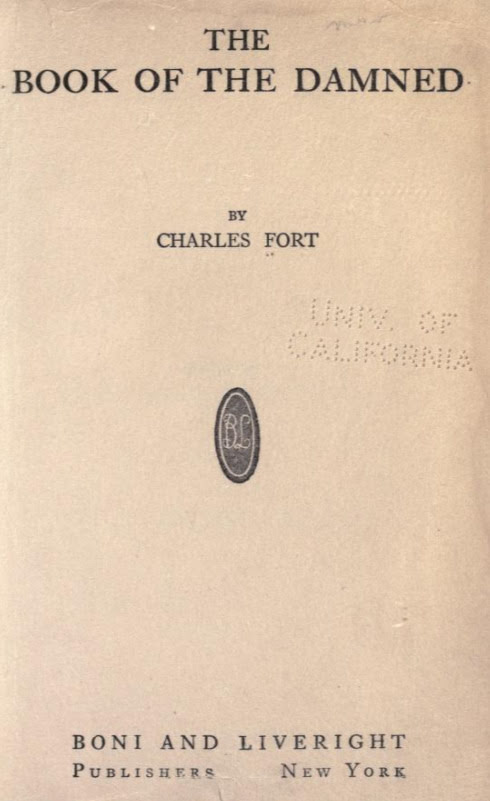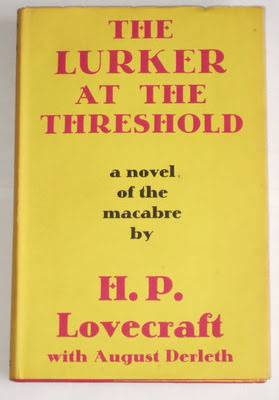A Patreon patron question for May 2024:
In “The Whisperer in Darkness” HPL mentions “the extravagant books of Charles Fort”. What did he actually think of Fort the man, and Fort’s influence on the topic of ‘phenomena that fall outside current understanding’?
Late in his life Lovecraft wrote to Fritz Leiber, Jr….
“I note your reference to the late Charles Fort — some of whose books I have read with extreme interest. I don’t think his scraps of bizarre reporting made out much of a case against accepted science, but I do tremendously admire the zeal & consistency of his delvings. He makes magnificent weird source-material!” (November 1936).
Hmmm, possibly used as source material? For Lovecraft? Interesting. In which case… which Fort books were read, and when? Well, Lovecraft first encountered Fort via The Book of the Damned (1919).
But exactly when was long unknown. Joshi stated several times (e.g. in Primal Sources) that he could not pin it down. We knew he read Damned because in September 1927 Lovecraft read Fort’s later book New Lands (1923), yet states he… “didn’t find it as interesting as [the earlier] The Book of the Damned” (Selected Letters II). Actually, “read” is misleading. Lovecraft states elsewhere that he… “skimmed over Charles Fort’s New Lands” rather than read it closely. The introduction by Booth Tarkington perhaps helps explain this skimming…
“Of his attack on the astronomers it can at least be said that the literature of indignation is enriched by it”
Lovecraft was an astronomer. One can see how, encountering the coruscation head-on in chapter two, Lovecraft might have skimmed the rest.
He could have read The Book of the Damned at any time between August 1926 and early 1920 (published December 1919, and it’s unlikely the master would have grabbed the book ‘hot off the press’ from New York). The timing of the book’s publication was opportune, with Fort presenting his material to the public on the cusp of modernity — between the dissolution of old certainties and the wavering establishment of the new modern ‘hard’ sciences.
However, we now know that Fort did not seed Lovecraft’s 1919-1926 period of writing. As S.T. Joshi writes in I Am Providence…
“Lovecraft, although having previously heard of Fort, did not read any of his work until Donald Wandrei lent him The Book of the Damned in March 1927.”
Right, so there we have it. Book of the Damned (1919) read in March 1927, and New Lands (1923) read by September 1927. It turns out that Lovecraft had…
“heard of him for years, but never read his stuff […] and now [Frank Belknap] Long, who has just encountered the material, tells me that it is marvellously weird and imaginatively captivating. Ford appears to be a man of some culture & ability, far above the usual run of ‘flat-earthers’ & kindred eccentrics.” (29th January 1927).
So here Lovecraft’s sentiment about the man is being filtered through Long’s gush. On actually reading Fort, Lovecraft’s impression was less positive…
“He is a fine author to skim, but an impossible one to read! What a fascinating jumble of rumours and traveller’s tales he has assembled & what a delicious set of conclusions he has drawn from them. He is distinctly above the average of such bizarre eccentrics & seems well versed in philosophy, though weak in science, psychology, & archaeology. I can understand why Long raved so violently about him [for Fort] is full of imaginative provocation, though the style is utterly hopeless.” (27th March 1927).
Here Lovecraft values Fort greatly as a collector, and somewhat as a dazzle-eyed wanderer in the realms of mysterious phenomena. But not as a writer, even a semi-surrealist one at times, and certainly not as a scientist dissecting “phenomena that fall outside current understanding”.
Incidentally, the books were apparently best-sellers. While the Providence Public Library may have been sniffy about stocking them, they cannot have been hard to find. But it seems Lovecraft needed Long’s spur, and then loans from Wandrei’s growing library, to actually obtain and read copies. The reading dates, now known to Lovecraftians, mean that Fort cannot have had an influence on the depiction of the correlation of widely separated mysterious events, such as in “The Call of Cthulhu” written a year or so earlier. The inspiration there is far more likely to lie back in Lovecraft’s boyhood reading of detective mysteries, and in his own collection of curious and weird cuttings in his scrapbooks. He kept his own voluminous scrapbooks, but they have not survived. Lovecraft states that he finally had his cuttings well-sorted and assembled into scrapbooks by October 1926, a long anticipated labour but one which required enough spare money to buy a large number of empty scrapbooks — and thus the process depicted in “Cthulhu” partly reflects his own sorting of his mounds of cuttings into ordered scrapbooks.
Did Fort’s books offer anything of special interest to Lovecraft? Well, take your pick from a wide range. But as Lovecraft states…
“No idea has ever fascinated me so much as that of the wafting of alien life across space, & I have enjoyed reading about these doubtful phenomena in books like Charles Fort’s eccentric Book of the Damned & New Lands!”.
So there is a possible slight influence on “The Whisperer in Darkness”, and Fort is certainly mentioned in the text. But ‘slight’ because Lovecraft was dealing in the transfer of life between systems well before he read Fort. Also because the Theosophists had similar ideas, as did the pulps. But perhaps Fort himself was an inspiration, since in “Darkness” the hero Wilmarth appears to spend much time in countering believers in Fortean phenomena. This perhaps hints at Lovecraft’s desire to put some distance between himself and “Fort’s influence on the topic” of an apparent abundance of ‘real-world weird’ material, as the master’s fan-base grew to encompass the many youngsters being influenced by Fort.
“The more I laughed at such theories, the more these stubborn friends asseverated them; adding that even without the heritage of legend the recent reports were too clear, consistent, detailed, and sanely prosaic in manner of telling, to be completely ignored. Two or three fanatical extremists went so far as to hint at possible meanings in the ancient Indian tales which gave the hidden beings a non-terrestrial origin; citing the extravagant books of Charles Fort with their claims that voyagers from other worlds and outer space have often visited earth. Most of my foes, however, were merely romanticists…” (from “The Whisperer in Darkness”).
But, as he wrote to one of these young fans — Emil Petaja — in 1935, Lovecraft the rationalist clearly saw such apparent mysteries through the prism of science. As misunderstandings, or as things logically explained… if one knew enough about physics, meteorology, natural history, and the cynicism of dime-extracting journalists.
“Assorted marvels like those in the eccentric books of Charles Fort are not hard to account for. Fort scraped up all sorts of press anecdotes of a certain type — which in turn were typical misstatements, misinterpretations, exaggerations, & distortions of actually observed things, or else hallucinations or fabrications. Track down any one of them to its reported place of occurrence, & the marvel evaporates. Unusual atmospheric effects, natural phenomena like the ‘fairy crosses’ of western Virginia, optical & chemical properties of dust storms & kindred things — these are the real sources of much of the Fort data. Another fruitful source is conscious press sensationalism — the kind of hokum peddled by the flamboyant American Weekly (of which [the writer] A. Merritt is associated!) or the Hearst rags. It ought to be significant that no genuine man of science has ever taken Fort seriously.” (31st May 1935, Selected Letters V).
A little later, in a letter to Petaja in June 1935, Lovecraft presses home the point for the lad. Fort is… “a curious nut, probably sincere — but infinitely gullible […] his books are interesting as a source of weird ideas, but have no other value.”
But did most of Lovecraft’s postumous fans know of Lovecraft’s faint distaste for Fort’s influence on youngsters? Perhaps not, for many decades. Since August Derleth’s popular best-seller The Lurker at the Threshold, supposedly written by/with Lovecraft, offered what appears to be a public endorsement of Fort. This could have been taken by many pre-1990s readers as reflecting Lovecraft’s own sentiments, rather than Derleth’s or the narrator’s…
“a very large, though usually suppressed, body of occurrences antipodally contradictory to the total scientific knowledge of mankind … some of which have been collected and chronicled in two remarkable books by […] Charles Fort — The Book of the Damned and New Lands — I commend them to your attention.”
So there we have it. As a man, Fort was deemed an admirable researcher, collector, and curator of a modern ‘cabinet of curiosities’, all of which allowed him to display a vivid imagination worthy of the master’s praise. As a publisher of what are said to have been 1920s best-sellers, Lovecraft might even have been a little envious, though he is silent on that point (other than to note in passing in spring 1931… “have you noticed how much more attention the fantastic and picturesque Charles Fort is receiving of late”). As a writer, Lovecraft did not admire Fort. Of course a writer is a sort of conjurer — with one hand he reveals himself in his text, while with the other he conceals. But Lovecraft does not seem to have detected any personality traits in the writing, beyond an obvious kookery and the limitations of Fort’s education and reading.
Lovecraft never met Fort in person, and so far as I know he never met anyone who had. He and Fort did not overlap while in New York City. In 1921 Fort set sail from New York City for London, Great Britain. There Fort quietly beavered away in the British Museum Library, supported by a timely inheritance from an uncle. Fort did not return to his home in NYC until 1929, by which time Lovecraft was long gone from the city.
Further reading:
The Fortean Influence on Science Fiction (2020).
Lovecraft & Fort: Martian Falcon (mystery dieselpunk novel set in New York in 1925, Lovecraft teams up with Fort).




A great discussion which clears up a number of questions about Fort’s influence on HPL.
Thank you!!!
Pingback: Hold the Fort | Tentaclii